
HTML Basic
HTML Reference
- HTML Tags
- <!--...-->
- <!DOCTYPE>
- <a>
- <abbr>
- <address>
- <area>
- <article>
- <aside>
- <audio>
- <b>
- <base>
- <bdi>
- <bdo>
- <blockquote>
- <body>
- <br>
- <button>
- <canvas>
- <caption>
- <cite>
- <code>
- <col>
- <colgroup>
- <data>
- <datalist>
- <dd>
- <del>
- <details>
- <dfn>
- <dialog>
- <div>
- <dl>
- <dt>
- <em>
- <embed>
- <fieldset>
- <figcaption>
- <figure>
- <footer>
- <form>
- <h1> to <h6>
- <head>
- <header>
- <hgroup>
- <hr>
- <html>
- <i>
- <iframe>
- <img>
- <input>
- <ins>
- <kbd>
- <label>
- <legend>
- <li>
- <link>
- <main>
- <map>
- <mark>
- <menu>
- <meta>
- <meter>
- <nav>
- <noscript>
- <object>
- <ol>
- <optgroup>
- <option>
- <output>
- <p>
- <param>
- <picture>
- <pre>
- <progress>
- <q>
- <rp>
- <rt>
- <ruby>
- <s>
- <samp>
- <script>
- <search>
- <section>
- <select>
- <small>
- <source>
- <span>
- <strong>
- <style>
- <sub>
- <summary>
- <sup>
- <svg>
- <table>
- <tbody>
- <td>
- <template>
- <textarea>
- <tfoot>
- <th>
- <thead>
- <time>
- <title>
- <tr>
- <track>
- <u>
- <ul>
- <var>
- <video>
- <wbr>
- HTML Deprecated Tags
- HTML Events
- HTML Global Attributes
- HTML Status Code
- HTML Language Code
- HTML Country Code
- HTML Charset
- MIME Types
HTML em Tag

Photo Credit to CodeToFun
🙋 Introduction
In HTML, the <em> tag plays a vital role in emphasizing text, conveying importance, or adding a subtle emphasis to certain words or phrases. This guide will delve into the details of using the HTML <em> tag effectively.
🤔 What is <em> Tag?
The <em> tag is an inline HTML element designed to represent text that should be emphasized. Browsers typically render emphasized text by italicizing it, although the exact appearance may vary based on the browser and styling.
💡 Syntax
To apply emphasis to your text using the <em> tag, wrap the desired content within the opening <em> and closing </em> tags.
<em>Your Emphasized Text Here</em>🧰 Attributes
The <em> tag generally does not require additional attributes. However, you can combine it with other tags and attributes to achieve more complex styling effects if needed.
<em class="highlight" style="font-weight: bold;">Your Styled Emphasized Text Here</em>📚 Common Use Cases
Basic Emphasis:
The primary use of the
<em>tag is to emphasize text within a sentence or paragraph.basic-emphasis.htmlCopiedIn this example, we need to <em>highlight</em> the importance of proper documentation.Nested Emphasis:
You can nest
<em>tags to apply emphasis to specific portions within already emphasized text.nested-emphasis.htmlCopiedThis is an <em>important <em>note</em></em> for all users.
🖥️ Browser Support
Understanding the compatibility of the <em> tag across different browsers is essential for delivering a consistent user experience. Here's an overview of its support:
- Google Chrome: Fully supported.
- Mozilla Firefox: Fully supported.
- Microsoft Edge: Fully supported.
- Safari: Fully supported.
- Opera: Fully supported.
- Internet Explorer: Fully supported.
Ensure you test your code in various browsers to guarantee a seamless experience for your audience.
🏆 Best Practices
- Use the
<em>tag to add semantic emphasis rather than solely relying on visual styling. - Avoid overusing emphasis, as it may dilute its impact.
- Test the rendering in different browsers to ensure consistent appearance.
🎉 Conclusion
Mastering the <em> tag is essential for web developers looking to add emphasis and importance to specific text elements. Proper usage contributes to a more accessible and well-structured content presentation.
👨💻 Join our Community:
Author

For over eight years, I worked as a full-stack web developer. Now, I have chosen my profession as a full-time blogger at codetofun.com.
Buy me a coffee to make codetofun.com free for everyone.
Buy me a Coffee












If you have any doubts regarding this article (HTML em Tag), please comment here. I will help you immediately.